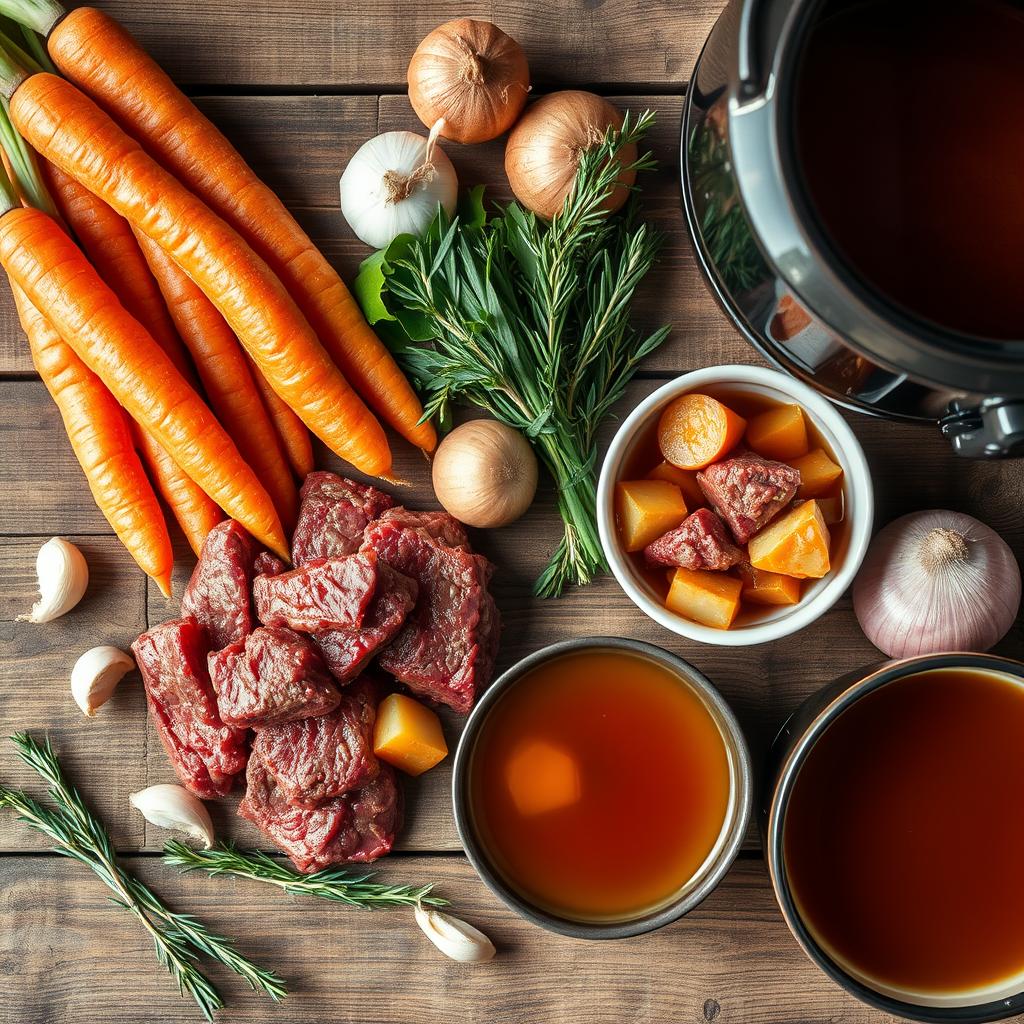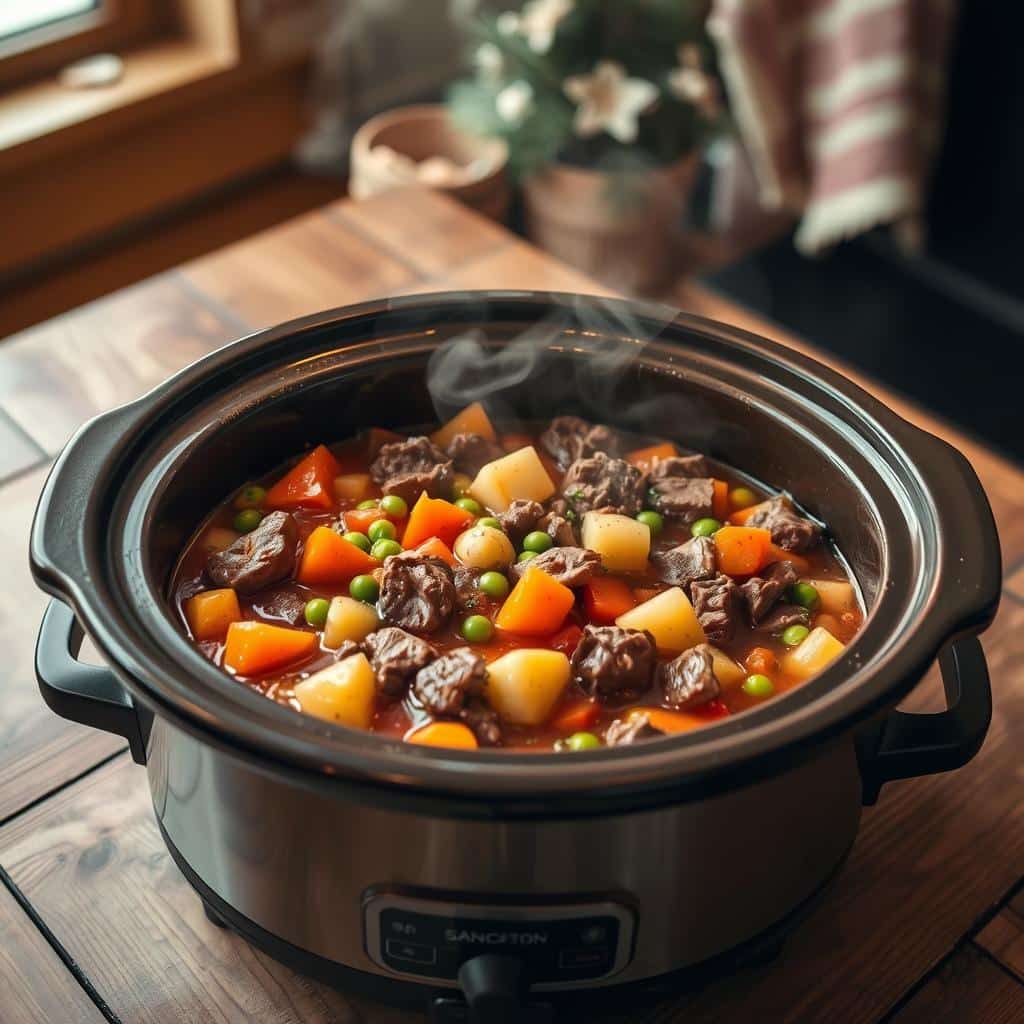When the cold winds blow, nothing beats the smell of a slow-cooker beef stew. The broth is rich, the beef is tender, and the veggies are fresh. This stew is a soul-warming meal that’s perfect for winter.
This recipe is easy to make and fills your home with a cozy aroma. It’s a classic comfort food that’s sure to warm you up on a chilly day.
Key Takeaways
- Slow-cooker beef stew is a comforting and convenient winter meal
- The recipe features tender beef, fresh vegetables, and a rich, flavorful broth
- Using a slow cooker makes this dish easy to prepare and lets the flavors meld together perfectly
- This recipe is perfect for feeding a crowd or enjoying as leftovers throughout the week
- Slow-cooker beef stew is a classic comfort food that’s sure to warm you up on a chilly day
Essential Ingredients for Perfect Slow-Cooker Beef Stew
Making a delicious slow-cooker beef stew begins with picking the right ingredients. Whether you’re an expert chef or a beginner, knowing the key ingredients is crucial. It affects the flavor and how tender the meat becomes.
Best Cuts of Beef for Slow Cooking
The type of beef you choose is very important for slow-cooked stew. Go for tougher cuts like chuck, short ribs, or brisket. These cuts get very tender after slow cooking, making the stew rich and flavorful.
Stay away from lean cuts like sirloin or tenderloin. They can dry out and become tough during the long cooking time.
Fresh vs. Frozen Vegetables
For the best slow-cooker beef stew, mix fresh and frozen vegetables. Fresh carrots, onions, and potatoes bring natural sweetness and texture. Frozen peas, green beans, or corn are a great, affordable choice.
Make sure to add the vegetables at the right time. This prevents them from getting overcooked or mushy.
Seasonings and Aromatics
The secret to a great slow-cooker beef stew is in the seasonings and aromatics. Use herbs like thyme, rosemary, and bay leaves. Add garlic, onions, and a bit of red wine for complex flavors. Feel free to try different spices and herbs to make it your own.

By choosing the right beef, vegetables, and seasonings, you’ll make a slow-cooker beef stew everyone will love. It’s sure to have your family and guests coming back for more.
Step-by-Step Preparation Guide
Making a delicious slow-cooker beef stew is easy and rewarding. It’s perfect for easy dinners, make-ahead meals, or family-friendly recipes. Follow this guide to make a stew that everyone will love.
Start by browning the beef. This step adds a rich flavor and makes the meat tender. Brown the beef in batches to get a nice sear, then put it in the slow cooker.
- In a large skillet, heat a tablespoon of oil over medium-high heat.
- Pat the beef cubes dry with paper towels and season them generously with salt and pepper.
- Working in batches, sear the beef on all sides until a deep brown crust forms, about 2-3 minutes per side.
- Transfer the seared beef to the slow cooker.
Then, chop the onions, carrots, and celery. Add them to the slow cooker with the beef. For a family-friendly touch, add potatoes or mushrooms too.
Next, add the liquids. Use beef broth and red wine or tomato sauce for flavor. Make sure there’s enough liquid to cover everything but not too much.
Season the stew with herbs and spices. Rosemary, thyme, and bay leaves are great choices. Adjust the seasoning to your liking. The longer it cooks, the better it tastes.

Follow these steps for a comforting make-ahead meal. Let the slow cooker work its magic. Enjoy the delicious smell of this easy dinners recipe in your home.
The Science Behind Slow-Cooker Beef Stew
Slow cooking turns tough beef into tender, delicious meat. This method lets flavors mix and meat soften. It’s all about the science.
Temperature and Timing Fundamentals
For great slow cooking, keep the heat low, between 200°F and 250°F. This slow cooking breaks down meat collagen into gelatin. This makes the meat tender and velvety.
The longer it cooks, the softer the beef gets.
Why Low and Slow Cooking Works
Low temperatures blend flavors, making the stew taste richer. Quick cooking can’t match this. The long cooking time also sweetens the veggies, adding to the dish’s flavor.
Tenderizing Tough Cuts
Slow cooking is perfect for tough beef like chuck or round. These cuts are full of connective tissue, making them chewy. But slow cooking breaks down this tissue, making the meat tender and juicy.
Whether you cook on low or high, give it enough time. This patience creates a comforting, delicious stew. It will warm you up inside.
| Setting | Cooking Time | Result |
|---|---|---|
| Low | 6-8 hours | Tender, fall-apart meat |
| High | 3-4 hours | Slightly firmer texture |
Tips for Making Your Stew More Flavorful
Creating the perfect hearty meals and comfort food like slow-cooker beef stew recipes is all about flavor. Using umami-rich ingredients and timing your seasoning right are key. Here are some expert tips to elevate your beef stew:
- Deglaze the pan: After browning the beef, don’t waste those flavorful browned bits. Use wine, broth, or vinegar to deglaze the pan. This captures all the delicious fond and adds it to your stew.
- Embrace umami: Ingredients like Worcestershire sauce, soy sauce, or parmesan cheese add a savory, umami flavor. Feel free to try these to enhance your beef stew.
- Time your herbs: Add fresh herbs like thyme, rosemary, and bay leaves at the start to infuse flavors. But add parsley or chives later to keep them fresh.
By using these simple tips, you can make your hearty meals and comfort food even better. A beef stew with complex flavors is the goal. It’s all about balancing and layering seasonings during cooking for a delicious dish.
“The secret to a great beef stew is patience and layering flavors. Take the time to develop that rich, velvety broth, and your stew will be a showstopper.”
Common Mistakes to Avoid When Making Beef Stew
Making a tasty slow-cooker beef stew can be tricky, especially for beginners. But, by avoiding common mistakes, you can make a stew that’s tender, flavorful, and comforting. Let’s look at the top mistakes to avoid when making why is my beef stew tough in slow cooker?
Temperature Control Issues
One big mistake is overcooking the stew. Slow cooking is great for tender meat, but too long can make it tough and dry. It’s important to keep the temperature right – aim for a gentle simmer. This helps your slow-cooker beef stew stay moist and tender.
Ingredient Preparation Errors
- Cutting the beef into uneven pieces: Inconsistent size can lead to some chunks becoming overcooked while others remain undercooked.
- Skipping the searing step: Browning the beef before slow cooking helps develop a deeper, richer flavor.
- Overcrowding the slow cooker: Leaving too little room between ingredients can prevent even cooking.
Seasoning Mistakes
Seasoning is crucial for a slow-cooker beef stew that’s truly satisfying. Not seasoning the meat before cooking or adding too many spices can make it taste bland or overpowering. Start with a mix of salt, pepper, and your favorite herbs and spices. Then, adjust the seasoning as the stew cooks.
By avoiding these common mistakes and making a few simple changes, you can make a why is my beef stew tough in slow cooker? that’s tender, flavorful, and comforting every time.
“The secret to a truly great slow-cooker beef stew is patience and attention to detail. Take the time to prepare your ingredients properly, and your efforts will be rewarded with a dish that warms the soul.”
Make-Ahead and Storage Solutions
Slow-cooker beef stew is the perfect make-ahead meal for busy nights or big gatherings. It’s easy to prepare ahead of time, making it a great choice for family-friendly recipes.
To start early, make the stew a day or two before. Just follow the recipe, cool it down, and then refrigerate it in an airtight container. When it’s time to eat, heat it up on the stovetop or in the microwave.
For longer storage, freeze the easy dinners. Cool the stew, then split it into portions or family servings. Store these in freezer-safe bags or containers. To serve, thaw it in the fridge overnight and reheat as needed.
| Refrigerator Storage | Freezer Storage |
|---|---|
| 3-4 days | 2-3 months |
Prepping for the week or stocking your freezer is easier with make-ahead meals like slow-cooker beef stew. These tips make reheating simple, so you can enjoy this comforting dish anytime.
Serving Suggestions and Pairings
Slow-cooker beef stew is a classic comfort food. It goes well with many sides. Try these ideas to make your meal even better.
Bread and Side Dish Options
Crusty bread or dinner rolls are essential with slow-cooker beef stew. They soak up the flavorful broth perfectly. Choose a fresh-baked baguette, sourdough, or fluffy dinner rolls for a great carb boost.
For a fuller side, mashed potatoes, roasted veggies, or a green salad are great. Mashed potatoes match the stew’s tender beef and veggies well. Roasted carrots, parsnips, or Brussels sprouts add nice contrasts in flavor and texture.
Wine Pairing Recommendations
A bold red wine is perfect with slow-cooker beef stew. Cabernet Sauvignon, Merlot, or Syrah work well. They match the stew’s rich flavors. For a lighter choice, Pinot Noir or Malbec can also pair well.
If you don’t drink wine, a dark beer or strong coffee is great too. Their malty, roasted flavors match the stew’s savory taste.
Pairing your slow-cooker beef stew with the right sides and drinks makes it unforgettable. It’s a meal that warms both your body and soul.
Variations of Traditional Slow-Cooker Beef Stew
The classic slow-cooker beef stew is a favorite comfort food. But, there are many ways to make it unique. You can add international flavors or make it healthier. The options are endless for this timeless dish.
Moroccan-Spiced Beef Stew is a tasty twist. It adds spices like cumin, cinnamon, and paprika. It also includes chickpeas and dried apricots for a sweet and savory taste.
Cauliflower Beef Stew is great for those watching their carbs. It replaces potatoes with cauliflower florets. This makes the stew healthier without losing flavor.
Beef and Barley Stew is perfect for a heartier meal. It adds chewy pearled barley for a satisfying texture. For a gluten-free option, try Beef Stew with Sweet Potatoes and Quinoa. The quinoa adds protein.
Choosing a variation means using quality ingredients and patience. Let the flavors mix slowly for the best taste. Try different flavors and ingredients to find your family’s favorite beef stew recipe or crock-pot recipe.
“The beauty of a slow-cooker beef stew is that it allows you to explore new flavors and ingredients while still delivering the comforting, familiar taste of a classic dish.”
Conclusion
Slow-cooker beef stew is a simple yet delicious dish. It can make your winter meals cozy and satisfying. By following a step-by-step guide and avoiding common mistakes, you can make a hearty, flavorful stew. Your family and friends will love it.
The secret to a perfect slow-cooker beef stew is using quality ingredients. Also, the right temperature and timing are key. Don’t forget to be patient. Try different seasonings and variations to make it your own. Enjoy making a warm and nourishing meal that captures the essence of slow-cooker beef stew, comfort food, and easy dinners.
Now, it’s time to start making your slow-cooker beef stew. Enjoy the rich, beefy flavors and the tender texture. Share this delicious dish with your loved ones. Create lasting memories around the table.
FAQ
What is the best cut of beef for slow-cooker beef stew?
For slow-cooker beef stew, choose tougher cuts like chuck roast, beef short ribs, or stew meat. These cuts get tender and flavorful when cooked slowly.
Should I use fresh or frozen vegetables in my slow-cooker beef stew?
Both fresh and frozen veggies work well in slow-cooker beef stew. Fresh veggies add texture and flavor. Frozen ones are convenient and nutritious. It’s up to you.
What are some essential seasonings and aromatics for slow-cooker beef stew?
Key seasonings and aromatics include garlic, onions, bay leaves, thyme, rosemary, Worcestershire sauce, and red wine (or beef broth). They enhance the stew’s rich flavor.
Is it better to cook stew on low or high in a slow cooker?
Cooking beef stew on low is best. It tenderizes the meat and develops flavors slowly. High heat can make the meat tough.
Why is my beef stew tough in the slow cooker?
Tough beef stew can be due to several reasons. Using lean cuts instead of marbled ones is a common mistake. Overcooking also dries out the meat. Not cooking long enough or cutting meat too large are other issues.
Can I make slow-cooker beef stew ahead of time?
Yes, slow-cooker beef stew is perfect for making ahead. Prepare it, cool it, then refrigerate for up to 4 days or freeze for months. Reheat when you’re ready.
What are some tasty pairings for slow-cooker beef stew?
Pair slow-cooker beef stew with sides like crusty bread, mashed potatoes, or roasted veggies. A fresh green salad is also great. For drinks, try a bold red wine or hearty beer.

